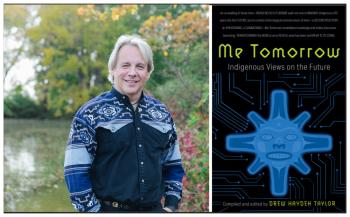Image Caption
Summary
Local Journalism Initiative Reporter
Windspeaker.com
From young water warrior Autumn Peltier to seasoned politician Romeo Saganash, the collection of works in Me Tomorrow: Indigenous Views on the Future paints a hopeful picture ahead for Indigenous peoples although at the same time suggesting wariness.
“I could have almost called the book The Seven Generations. I think that was the primary theme of this book: Every decision we make will have an effect seven generations down the road. Let’s look at the seventh generation, that sixth generation. Let’s see where we will be and what our decisions, the positiveness and potentially the negativeness of those decisions, (will be),” said Drew Hayden Taylor, who compiled and edited the 10 essays and one poem.
Me Tomorrow is the fourth – and unplanned – compilation of works from Taylor, an author, playwright and columnist from Curve Lake First Nation in Ontario. His previous three, Me Funny (2006), Me Sexy (2008) and Me Artsy (2015), and now Me Tomorrow all explore different aspects of Indigenous culture.
When he was approached by his publisher for a fourth volume in the series, Taylor says he was inspired by the popularity of his collection of science fiction short stories and the growing interest in science fiction work by other Indigenous authors.
He also thought about the common perception that Indigenous people were always looking backwards at where they had come from, what they had lost, what they were trying to get back, and what they had retained.
“It’s always in a past tense kind of perspective. Working on my sci-fi collection, et cetera, I became more and more interested, more curious about turning that lens around and looking to the future. Where will we be in 10 years, in 30 years, in 50 years?” said Taylor.
With that in mind, he approached First Nations, Métis and Inuit experts in various segments of contemporary society—education, environment, politics, and language—and asked them to write 3,000 to 5,000 words “about where they think Indigenous people will be or should be in some indefinable time period in the future.”
Almost everyone accepted Taylor’s invitation.
“Some people approached it as a clinical essay on the topic. Other people embraced it in more of a storytelling tradition … I left it up to them to find their own voice to explore the topic,” said Taylor.
He views the contributions as “their windows to the future, their perceptions on development of their people.”
The same holds true for the book’s cover art. Entitled “Motherboard,” Tsleil-Waututh territory artist Jordana George explained her work as “a nod to how Indigenous people’s relationship to the land and water is not merely a historical notion but a connection that persists in the present and will be sustained far into the future.”
Taylor’s contribution was a “little deconstruction” piece where, because he is a science fiction fan, he decided to use that genre to academically examine the subject.
“Most of the portrayal of Indigenous people in science fiction happened decades ago and I thought it would be interesting coming up and seeing, ‘Okay, did they see anything or are they completely off topic?’” he said.
Taylor admits he was surprised by the positive outlook that the majority of writers shared.
“Many of the contributors felt that there is hope, there is light in the future, that we will continue to be strong and get stronger. Many have concerns and certain fears about our journey into the future, but overall I was really delighted and pleased at the sense of optimism that was envisioned in this book,” he said.
It’s this positive outlook that Taylor hopes both Indigenous and non-Indigenous readers take away from the compilation.
“It’s the thing that we are not people of the past. We are people of the present and of the future,” he said.
“Indigenous cultures, all of them, are evolving. We are an evolving people. Anything that does not evolve stagnates and anything that stagnates will probably become extinct. We're not in danger of becoming extinct. What this book shows is our vision of the future and what we're doing to achieve that vision.”
Me Tomorrow: Indigenous Views on the Future will be available on Oct. 30 and can be purchased online from the publishers Douglas & McIntyre.
Local Journalism Initiative Reporters are supported by a financial contribution made by the Government of Canada.

